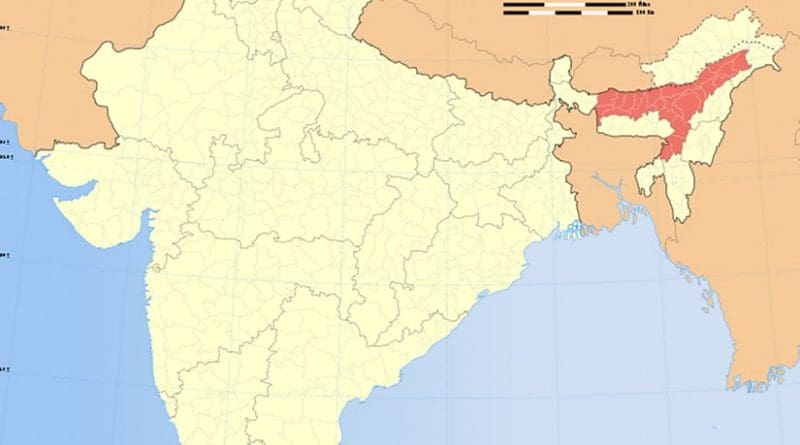Raising Anti-Dam Voices In New Delhi
While anti-big dam protesters have assembled in eastern Assam for a mammoth public rally at Thekeraguri, serious concern has been expressed in the national capital in an intense discussion.
Addressing the rally at North Lakhimpur Thursday organized by various anti-dam groups, eminent environmentalist and Narmada Bachao Andolan leader Medha Patkar reiterated her stand that the people living in the catchment areas own a river and hence their interest must not be sacrificed to please the corporate players while going for larger hydro-electricity projects in India.
Meanwhile, attending a dialogue in memory of pioneer environmental journalist and activist of international repute, Anil Agarwal various speakers put forwards their fears that the hydro-electricity projects in Arunachal Pradesh and Assam would leave a devastating impact on the northeastern part of India and also in Bangladesh.
Organized by the Centre for Science and Environment (CSE) at India Habitat Centre, New Delhi, the two-day event on February 24-25 was started with a keynote address by Sunita Narain, editor of Down To Earth, a CSE publication, where over 150 environment activists and journalists across the country have participated.
“The dialogue is expected to being various issue and concerns on green clearances with all the stakeholders including the government, industry and civil societies and go ahead with it,” added Ms Narain, who also functions as Director General to CSE.
Making his points in front of the gathering, Akhil Gogoi of Krishak Mukti Sangram Samity insisted that the Central government has maintained the tendency to exploit the resource of northeast India without accountabilities.
“New Delhi is expecting over 65000 MW from our region, but the government has not taken the people into confidence. The process of public hearing for environment clearances becomes so much undemocratic. So one can find the environment impact assessment looks like a project report of the concerned company,” Akhil said.
The young activist from Assam concluded saying that there should be an independent consortium of both regional and national experts, set-up to conduct environment impact assessment studies. Before conducting studies, the experts should also have a mandate from the local communities. Under no circumstances should such studies be funded by project proponents. Advance downstream impact assessment and public consultation in the entire Brahmaputra floodplains in Assam should be mandatory for upstream dams, he asserted.
Earlier addressing the gathering, Partha J Das of Aaranyak (Guwahati) highlighted the overview of the government policy for Green Clearance to various hydro-electricity projects in northeast India. He revealed in his presentation that already 147 MoUs (out of 168 planned large HEPs in the region) had been signed with the Arunachal government (till July 2011).
“At least 55 projects have obtained scoping clearance and 12 projects (LSHEP for 2000 MW at Subansiri, Ranganadi-I for 405 MW at Ranganadi, Kameng for 600 MW at Kameng, Siyom /Middle Siang for 1000 MW at Siyom, Demwe Lowe for 1750MW at Lohit, Tawang-I for 750 MW at Tawang, Tawang-II for 750 MW at Tawang, Pare for 110 MW at Pare/Dikrong, Tato-II for 700 MW at Siang, Khuitam Lewuitkare for 66 MW at Gang/Bishom/Kameng, Gongri for 90 MW at Kameng) have received the final Environment Clearance in the bio-diversity hotspot region,” Mr Das pointed out.
He however argued that the environment impact assessment process, based on which the clearances are given, are inferior and misleading.
Moreover the cumulative environment impact assessment is not done in-spite of the fact that the basins of each major river would have multiple projects. Similarly, the adequate study on downstream impacts is ignored jeopardizing ecosystems, lives and livelihoods, he added.
Moderated by Himanshu Thakkar of South Asia Network on Dams, River & People, the session was also addressed by Chandra Bhushan of CSE and Bimal Bhai from Matu Jan Sangathan where Pema Lepcha of Affected Citizens of Teesta from Sikkim, Vijay Taram of Forum for Siang Dialogue from Arunachal Pradesh, Arwat Challam of Samrakshan Trust from Meghalaya and Neeraj Vagholikar of Kalpavriksh interacted and highlighted about the environmental and social concerns on the huge hydro-electricity projects in northeast India.
Speaking to this writer Neeraj Vagholikar argued that several large hydropower projects in the Northeast were granted green clearances without prior downstream impact assessment by the Ministry of Environment and Forests (MoEF) in New Delhi.
“This serious lacuna in environmental decision-making is one of the root causes of the ongoing conflict in Assam. However, no lessons seem to have been learnt by the MoEF through the Lower Subansiri experience,” said Mr Vagholikar adding that the authority had recently granted wildlife clearance to the 1750 MW Demwe Lower project and again asked for post-clearance downstream studies.
“In light of this short-sighted decision-making, this dialogue on green clearances in New Delhi is important. Both academics and activists from the Northeast have highlighted the serious social and environmental concerns in current green clearances being granted to large hydropower projects in the region,” he warped up.
Mentionable that the CSE carried out a detailed and comprehensive analysis of the clearances granted in the last five years – and the findings are nothing less than startling. In the last five years, the country has seen more clearances than those planned for even during the 11th and 12th Five Year Plans, asserted Chandra Bhushan. He also rubbished that a viewpoint is currently voiced in some forums in India that environmental and forest clearances are hampering economic development by delaying various projects in the country.

